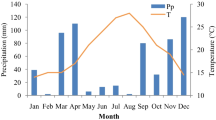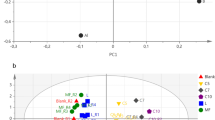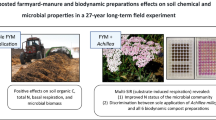Abstract
The morpho-physiological quality of seedlings is negatively affected by the wide scale use of forest soils as substrates in developing countries. With the objective of finding long-term sustainable supply of growing media, compost was produced from shredded branches of three fast growing species (Acacia cyanophylla (AA), Acacia cyclops (AS) and Eucalyptus gomphocephala (EG). The composting process covered three different periods over the course of a year. Pile temperatures were monitored daily and the composts were routinely sampled and analyzed for 19 chemical variables. Although composting is feasible year-round in arid climates, compost produced in the humid cool conditions of autumn, winter and early spring reaches the maturation phase more quickly than compost produced under hot, dry summer conditions. It also requires less turning and water. The evolution of the composting process and quality of the final product can be assessed using three chemical variables (C/N, pH, EC). Seed germination rates in the three types of compost were similar to that in a peat:vermiculite substrate and vigorous high quality seedlings were produced in the two acacia composts. However, compost-grown seedlings had significantly smaller shoots and root systems than those produced in peat substrate. Principal components analyses showed that the quality of a compost-based substrate is reproducible and that its final chemical composition can be predicted from its raw organic materials. The EG composts had higher pH than the acacia composts, whereas the AA and EG composts were higher in mineral salts than the AS.



Similar content being viewed by others
References
Abad M, Noguera P, Burés S (2001) National inventory of organic wastes for use as growing media for ornamental potted plant production: case study in Spain. Bioresour Technol 77:197–200
Aggangan RT, O’Connell AM, McGrath JF, Dell B (1999) The effect of Eucalyptus globulus Labill. leaf litter on C and N mineralization in soils from pasture and native forest. Soil Biol Biochem 31:1481–1487
Agnew JM, Leonard JJ (2003) The physical properties of compost. Compos Sci Util 1(3):238–264
Allaire SE, Caron J, Menard C, Dorais M (2005) Potential replacements for rockwool as a growing substrate for greenhouse tomato. Can J Soil Sci 85:67–74
Ammari Y, Lamhamedi MS, Akrimi N, Zine El Abidine A (2003) Compostage de la biomasse forestière et son utilisation comme substrat de croissance pour la production de plants en pépinière forestières modernes. Revue de l’I.N.A.T., Tunisie 18:99–119
Aparna C, Saritha P, Himabindu V, Anjaneylu Y (2008) Techniques for the evaluation of maturity for composts of industrially contaminated lake sediments. Wast Manag 28:1773–1784
Bernal MP, Navarro AF, Roig A (1996) Carbon and nitrogen transformation during composting of sweet sorghum bagasse. Biol Fertile Soils 22:141–148
Bernier PY, Gonzalez A (1995) Effects of the physical properties of Sphagnum peat on the nursery growth of containerized Picea mariana and Picea glauca seedlings. Scand J Forest Res 10:176–183
Brady N (1974) The nature and properties of soils, 8th edn. Macillan Publishing Co., Inc. New York, NY
Brewer LJ, Sullivan DM (2003) Maturity and stability evaluation of composted yard trimmings. Compos Sci Util 11(2):96–112
Bugbee G, Frink CR (1986) Aeration of potting media and plant growth. Soil Sci 141:438–441
Bunt AC (1988) Media and mixes for container-grown plants. Second edition of modern potting composts: a manual on the preparation and use of growing media for pot plants. Unwin Hyman, London
Canhoto C, Graça MAS (1999) Leaf barriers to fungal colonization and shredders (Tipula lateralis) consumption of decomposing Eucalyptus globulus. Microb Ecol 37:163–172
Caron J, Nkongolo NV (2004) Assessing gas diffusion coefficients in growing media from in situ water flow and storage measurements. Vadose Zone J 3:300–311
Chander K, Goyal S, Kapoor KK (1995) Microbial biomass dynamics during the decomposition of leaf litter of poplar and eucalyptus in a sandy loam. Biol Fertil Soils 19:357–362
Charest MH, Beauchamp CJ (2002) Composting of de-inking paper sludge with poultry manure at three nitrogen levels using mechanical turning: behavior of physico-chemical parameters. Bioresour Technol 81:7–17
Corti C, Crippa L, Genevini PL, Cetemero M (1998) Compost use in plant nurseries: Hydrological and physiochemical characteristics. Compos Sci Util 6(1):35–45
Davis AS, Jacobs DF, Wightman KE, Birge ZKD (2006) Organic matter added to bareroot nursery beds influences soil properties and morphology of Fraxinus pennsylvanica and Quercus rubra seedlings. New For 31:293–303
Déportes I, Benoit-Guyod JL, Zmirou D (1995) Hazard to man and the environment posed by the use of urban waste compost: a review. Sci Total Environ 172:197–222
Desalegn G, Binner E, Lechner P (2008) Humification and degradability evaluation during composting of horse manure and biowaste. Compos Sci Util 16(2):90–98
Dewes T (1992) Loss of nitrogenous compounds during composting of animal wastes. Bioresour Technol 42:103–111
D’Imporzano G, Adani F (2007) The contribution of water soluble and water insoluble organic fractions to oxygen uptake rate during high rate composting. Biodegradation 18:103–113
Dimambro ME, Lillywhite RD, Rahn CR (2007) The physical, chemical and microbial characteristics of biodegradable municipal waste derived composts. Compos Sci Util 15(4):243–252
Espiau P, Peyronel A (1976) L’acidité d’échange dans les sols. Methode de détermination de l’aluminium échangeable et des protons échangeables. Science du Sol 3:161–175
Fenner N, Ostle NJ, McNamara N, Sparks T, Harmens H, Reynolds B, Freeman C (2007) Elevated CO2 effects on peatlands plant community carbon dynamics and DOC production. Ecosystems 10:635–647
Fitzpatrick GE (2001) Compost utilization in ornamental and nursery crop production systems. In: Stoffella PJ, Kahn BA (eds) Compost utilization in horticultural cropping systems. Lewis Publishers. CRC Press LLC, pp, pp 135–149
Harada Y, Inoko A (1980) Relationship between cation exchange capacity and degree of maturity of city refuse. Soil Sci Plant Nutr 26:353–362
Heiskanen J (1993) Favourable water and aeration conditions for growth media used in containerized tree seedling production: A review. Scand J Forest Res 8:337–358
Hendershot WH, Lalande H, Duquette M (2008) Ion exchange and exchangeable cations. 2nd edn. In: Carter MR, Gregorich EG (eds) Soil sampling and methods of analysis. CRC Press Boca Raton, FL, pp 197–206
Ko HJ, Kim KY, Kim HT, Kim CN, Umeda M (2008) Evaluation of maturity parameters and heavy metal contents in composts made from animal mature. Waste Manage 28:813–820
Lamhamedi MS, Ammari Y, Fecteau B, Fortin JA, Margolis H (2000) Problématique des pépinières forestières en Afrique du Nord et stratégie de développement: synthèse. Cah Agric 9:369–380
Lamhamedi MS, Fecteau B, Godin L, Gingras C (2006) Guide pratique de production en hors sol de plants forestiers, pastoraux et ornementaux en Tunisie. Projet ACDI E 4936-K061229. Pampev Internationale, Direction Générale des Forêts, Tunisie (eds). ISBN:9973-914-08-2
Lamhamedi MS, Abourouh M, Fortin JA (2009) Technological transfer: the use of ectomycorrhizal fungi in conventional and modern forest tree nurseries in northern Africa. In: Khassa D, Piché Y, Coughlan AP (eds) Advances in mycorrhizal science and technology. NRC-CNRC Press, Ottawa, pp 139–152
Landis TD (1990) Growing media. In: Containers and growing media, Vol. 2, The Container Tree Nursery Manual. Agric. Handbook 674. USDA(FS) Washington
Landis TD, Khadduri N (2008) Composting application in forest and conservation nurseries. USDA(FS). Forest Nursery Notes 28(2):9–18
Lapeyrie FF, Chilvers GA (1985) An endomycorrhiza-ectomycorrhiza succession associated with enhanced growth of Eucalyptus dumosa seedlings planted in a calcareous soil. New Phytol 100:93–104
Larney FJ, Hao X (2007) A review of composting as a management alternative for beef cattle manure in southern Alberta, Canada. Bioresour Technol 98:3221–3227
Larney FJ, Olson AF, Carcamo AA, Chi Chang (2000) Physical changes during active and passive composting of beef feedlot manure in winter and summer. Bioresour Technol 75:139–148
Lazcano C, Sampedro L, Zas R, Dominguez J (2010) Vermicompost enhances germination of the maritime pine (Pinus pinaster Ait.). New For 39:387–400
Lemaire F, Dartigues A, Rivière LM, Charpentier S, Morel P (2003) Cultures en pots et conteneurs: Principes agronomiques et applications. INRA, France
Mañas P, Castro E, De las Heras J (2009) Quality of maritime pine (Pinus pinaster Ait.) seedlings using waste materials as nursery growing media. New For 37:295–311
Manios T (2004) The composting potential of different organic solid wastes: experience from the island Crete. Environ Int 29:1079–1089
Manios T, Maniadakis K, Frantzeskaki N, Stentiford EI, Manios V, Kritsotakis I, Dialynas G (2003) Sewage sludge composting on the Island of Crete. BioCycle 44:53–55
Manios T, Maniadakis K, Kalogeraki M, Mari E, Stratakis E, Terzakis S, Boytzakis P, Naziridis Y, Zampetakis L (2006) Efforts to explain and control the prolonged thermophilic period in two-phase olive oil mill sludge composting. Biodegradation 17:285–292
Miller JH, Jones N (1995) Organic and compost-based growing media for tree seedling nurseries. World Bank Technical Paper Number 264. Forestry series
Muhammad Khalid I, Tahira Sh, Khurshed A (2010) Effect of different techniques of composting on stability and maturity of municipal solid waste compost. Environ Technol 31(2):205–214
Mustin M (1987) Le compost: Gestion de la matière organique. Tec & Doc, Paris
Noble R, Coventry E (2005) Suppression of soil-borne plant diseases with composts: A review. Biocontrol Sci Technol 15:3–20
Osawa T, Namiki M (1981) A novel type of antioxidant isolated from leaf wax of Eucalyptus leaves. J Agric Biol Chem 45(3):735–739
Paré T, Dinel H, Schnitzer M, Dumontet S (1998) Transformation of carbon and nitrogen during composting of animal manure and shredded paper. Biol Fertil Soils 26:173–178
Pérez-Corona ME, Pérez-Hernandez MC, De Castro FB (2006) Decomposition of alder, ash, and poplar litter in a Mediterranean riverine area. Comm Soil Sci Plan 37:1111–1125
Ribeiro HM, Romero AM, Pereira H, Borges P, Cabral F, Vasconcelos E (2007) Evaluation of a compost obtained from forestry wastes and solid phase of pig slurry as a substrate for seedlings production. Bioresour Technol 98:3294–3297
Roe NE (2001) Compost effects on crop growth and yield in commercial vegetable cropping systems. In: Stoffella PJ, Kahn BA (eds) Compost utilization in horticultural cropping systems. Lewis Publishers, CRC Press, LLC, pp 123–133
Rosen CJ, Halbach TR, Swanson TR (1993) Horticultural uses of municipal solid waste components. HortTechnology 3:167–173
Rosso L, Lobry JR, Bajard S, Flandrois JP (1995) Convenient model to describe the combined effects of temperature and pH on microbial growth. Appl Environ Microbiol. Am Soc for Microbiol 61(1):610–616
Said-Pullicino D, Gigliotti G (2007) Oxidative biodegradation of dissolved organic matter during composting. Chemosphere 68:1030–1040
Salètes S, Siregar FA, Caliman JP, Liwang T (2004) Ligno-cellulose composting: Case study on monitoring oil palm residuals. Compos Sci Util 12(4):372–382
Sanchez-Monedero MA, Roig A, Paredes C, Bernal MP (2001) Nitrogen transformation during organic waste composting by the Rutgers system and its effects on pH, EC and maturity of the composting mixtures. Bioresour Technol 78:301–308
Schultz JC, Hunter MD, Appel HM (1992) Antimicrobial activity of polyphenols mediates plant-herbivore interactions. In: Hemingway RW, Laks PE (eds) Plant polyphenols: synthesis. properties, significance. Plenum Press, New York NY, pp 621–637
Sena MM, Frighetto RTS, Valarini PJ, Tokeshi H, Poppi RJ (2002) Discrimination of management effects on soil parameters by using principal component analysis: a multivariate analysis case study. Soil Till Res 67:171–181
Sullivan DM, Miller RO (2001) Compost quality attributes, measurements, and variability. In: Stoffella PJ, Kahn BA (eds) Compost utilization in horticultural cropping systems. Lewis Publishers. CRC Press LLC, pp, pp 95–120
Sundberg C, Smars S, Jönsson H (2004) Low pH as an inhibiting factor in the transition from mesophilic to thermophilic phase in composting. Bioresour Technol 95:145–150
Veijalainen AM, Juntunen ML, Lilja A, Heinonen-Tanski H (2007a) Forest Nursery waste composting in windrows with or without horse manure or urea–the composting process and nutrient leachting. Silva Fenn 41:13–27
Veijalainen AM, Juntunen ML, Heiskanen J, Lilja A (2007b) Growing Picea abies container seedlings in peat and composted forest-nursery waste mixtures for forest regeneration. Scand J Forest Res 22:390–397
Walinga I, Van Der Lee JJ, Houba VJG, Van Vark W, Novozamsky I (1995) Plant analysis manual. Kluwer Academic Publishers, Dordrecht, Netherlands
Ward BB, Courteney KJ, Langenheim JH (1997) Inhibition of Nitrosomonas europaea by monoterpenes from coastal redwood (Sequoia sempervirens) in whole-cell studies. J Chem Ecol 23(11):2583–2598
Warner BG, Asada T (2006) Biological diversity of peatlands in Canada: Overview article. Aquat Sci 68:240–253
Wedderburn ME, Carter J (1999) Litter decomposition by four functional tree types for use in silvopastoral systems. Soil Biol Biochem 31:455–461
Acknowledgments
To the team of employees and research assistants at the Centre régional de la recherche forestière de Marrakech, Dr. Mohamed Abourouh of la Division de Recherche et d’Expérimentations Forestières à Rabat as well as Mario Renaud, Linda Veilleux and Denis Langlois of la Direction de la recherche forestière de Québec. We are also grateful to Dr. Papaniokhor Diouf for his assistance with the chemical tests and to Arthur Goussanou and Denis Talbot for their contribution to the statistical analyses. Financial support for this project was provided to Dr. Mohammed S. Lamhamedi by the ministère des Ressources naturelles et de la Faune du Québec (project: 112310094) and to Dr. Hank Margolis by the Fonds de recherche sur la nature et les technologies (project 2008-FT-124372).
Author information
Authors and Affiliations
Corresponding author
Rights and permissions
About this article
Cite this article
Bakry, M., Lamhamedi, M.S., Caron, J. et al. Are composts from shredded leafy branches of fast-growing forest species suitable as nursery growing media in arid regions?. New Forests 43, 267–286 (2012). https://doi.org/10.1007/s11056-011-9280-x
Received:
Accepted:
Published:
Issue Date:
DOI: https://doi.org/10.1007/s11056-011-9280-x




